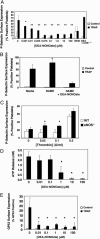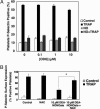Regulation of platelet granule exocytosis by S-nitrosylation
- PMID: 15738422
- PMCID: PMC553307
- DOI: 10.1073/pnas.0408310102
Regulation of platelet granule exocytosis by S-nitrosylation
Abstract
Nitric oxide (NO) regulates platelet activation by cGMP-dependent mechanisms and by mechanisms that are not completely defined. Platelet activation includes exocytosis of platelet granules, releasing mediators that regulate interactions between platelets, leukocytes, and endothelial cells. Exocytosis is mediated in part by N-ethylmaleimide-sensitive factor (NSF), an ATPase that disassembles complexes of soluble NSF attachment protein receptors. We now demonstrate that NO inhibits exocytosis of dense granules, lysosomal granules, and alpha-granules from human platelets by S-nitrosylation of NSF. Platelets lacking endothelial NO synthase show increased rolling on venules, increased thrombosis in arterioles, and increased exocytosis in vivo. Regulation of exocytosis is thus a mechanism by which NO regulates thrombosis.
Figures





Similar articles
-
HMG-CoA reductase inhibitors inhibit endothelial exocytosis and decrease myocardial infarct size.Circ Res. 2005 Jun 10;96(11):1185-92. doi: 10.1161/01.RES.0000170229.49776.81. Epub 2005 May 19. Circ Res. 2005. PMID: 15905463 Free PMC article.
-
Molecular mechanisms of platelet exocytosis: role of SNAP-23 and syntaxin 2 in dense core granule release.Blood. 2000 Feb 1;95(3):921-9. Blood. 2000. PMID: 10648404
-
N-ethylmaleimide-sensitive factor: a redox sensor in exocytosis.Biol Chem. 2006 Oct-Nov;387(10-11):1377-83. doi: 10.1515/BC.2006.173. Biol Chem. 2006. PMID: 17081110 Review.
-
A role for Sec1/Munc18 proteins in platelet exocytosis.Biochem J. 2003 Aug 15;374(Pt 1):207-17. doi: 10.1042/BJ20030610. Biochem J. 2003. PMID: 12773094 Free PMC article.
-
[Role of nitric oxide/cGMP system in platelet function].Nihon Rinsho. 2004 Sep;62 Suppl 9:500-4. Nihon Rinsho. 2004. PMID: 15506436 Review. Japanese. No abstract available.
Cited by
-
A Divergent Platelet Transcriptome in Patients with Lipedema and Lymphedema.Genes (Basel). 2024 Jun 4;15(6):737. doi: 10.3390/genes15060737. Genes (Basel). 2024. PMID: 38927673 Free PMC article.
-
Inhibition of N-ethylmaleimide-sensitive factor protects against myocardial ischemia/reperfusion injury.Circ Res. 2007 Dec 7;101(12):1247-54. doi: 10.1161/CIRCRESAHA.107.162610. Epub 2007 Oct 11. Circ Res. 2007. PMID: 17932325 Free PMC article.
-
HMG-CoA reductase inhibitors inhibit endothelial exocytosis and decrease myocardial infarct size.Circ Res. 2005 Jun 10;96(11):1185-92. doi: 10.1161/01.RES.0000170229.49776.81. Epub 2005 May 19. Circ Res. 2005. PMID: 15905463 Free PMC article.
-
Signaling-mediated functional activation of inducible nitric-oxide synthase and its role in stimulating platelet activation.J Biol Chem. 2008 Oct 24;283(43):28827-34. doi: 10.1074/jbc.M801646200. Epub 2008 Aug 27. J Biol Chem. 2008. PMID: 18753139 Free PMC article.
-
The nuts and bolts of the platelet release reaction.Platelets. 2017 Mar;28(2):129-137. doi: 10.1080/09537104.2016.1240768. Epub 2016 Nov 16. Platelets. 2017. PMID: 27848265 Free PMC article. Review.
References
-
- Moncada, S., Palmer, R. M. & Higgs, E. A. (1991) Pharmacol. Rev. 43, 109-142. - PubMed
-
- Loscalzo, J. (2001) Circ. Res. 88, 756-762. - PubMed
-
- Cirino, G., Fiorucci, S. & Sessa, W. C. (2003) Trends Pharmacol. Sci. 24, 91-95. - PubMed
-
- Radomski, M. W., Palmer, R. M. & Moncada, S. (1987) Lancet 2, 1057-1058. - PubMed
Publication types
MeSH terms
Substances
Grants and funding
- HL 074945/HL/NHLBI NIH HHS/United States
- R01 HL 63706/HL/NHLBI NIH HHS/United States
- P01 HL065608/HL/NHLBI NIH HHS/United States
- P01 HL 56091/HL/NHLBI NIH HHS/United States
- P01 HL056091/HL/NHLBI NIH HHS/United States
- T32 RR007002/RR/NCRR NIH HHS/United States
- RR 07002/RR/NCRR NIH HHS/United States
- R01 HL 074061/HL/NHLBI NIH HHS/United States
- R01 HL074061/HL/NHLBI NIH HHS/United States
- R01 HL063706/HL/NHLBI NIH HHS/United States
- K08 HL074945/HL/NHLBI NIH HHS/United States
- P01 HL 65608/HL/NHLBI NIH HHS/United States
LinkOut - more resources
Full Text Sources
Other Literature Sources

